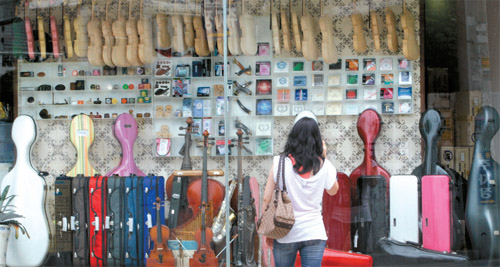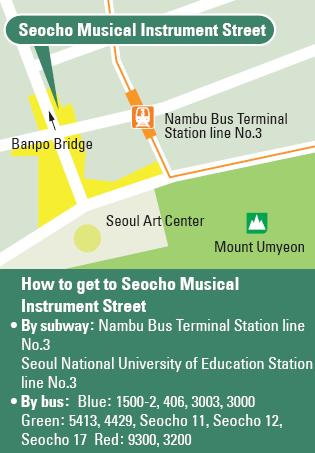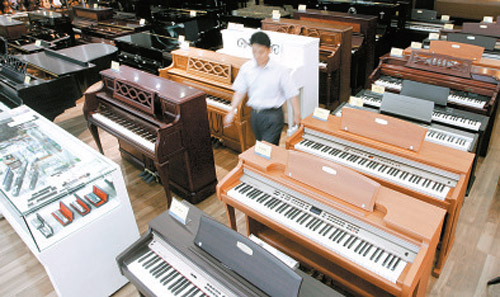Anyone can pull strings on Seocho music street

A customer and her mother choose a cello from City Music, a store along Seocho musical instrument street, in Gangnam. By Oh Sang-min
The girl couldn’t move. She stared at the instruments like they were Barbie dolls.
“My husband and I thought it was about time that she learned how to play an instrument,” said her mom, Kim Gyeong-ja, 45. “We never had a chance to learn to play a classical musical instrument when we were growing up, so we wanted our daughter to do so, because we believe it will allow her to enjoy and appreciate classical music throughout her life.”
Kim said she came to Seocho because she heard that it was the neighborhood where both beginners and masters buy and repair their instruments.
It’s not difficult to spot a student walking along the Seocho streets carrying a huge oversized instrument on his or her back.
Seocho has been the center of Korea’s classical music scene for more than two decades. The streets from the Seoul Arts Center to the Seoul National University of Education are filled with shops that sell or repair classical musical instruments, ranging from string instruments, like violins, to wind and brass instruments, like flutes. French horns, clarinets, trumpets, tubas and trombones also abound.
There are roughly 80 classical stores and repair shops in the neighborhood, the highest concentration of such shops in the country.
Unlike their northern brethren in Nakwon, where musical instrument shops are clustered in a single building, the stores are scattered about, with many situated deep within alleys.
It was around the 1990s that such stores started to congregate in the neighborhood.
“The Seoul Arts Center was built in 1988 around the time of the Seoul Olympic games,” said La Ho-cheon, vice president of Cosmos Corp. “We were one of the early stores to set up in this neighborhood.”
Cosmos sells everything from classical to modern rock instruments like electric guitars and accordions.
“Seocho grew as the country’s center of classical music because of the Seoul Arts Center, where classical musicians and students perform and learn,” La said.

A young customer stares into the window displaying various instruments, including violins. The instruments have colorfully decorated hard covers at Hyun Dai Musical Instruments located along the Seocho classical music instrument street in Gangnam. By Oh Sang-min
“Nakwon became a neighborhood that specialized in electronic instruments while Seocho [is more] a neighborhood catering to instruments used in classical music.”
La said most of the stores in Seocho deal in string instruments rather than woodwinds or brass. “If you really think about it, there are more string performers in classical music than wind or brass,” said La. “In an orchestra out of 120 players, roughly 90 or so play string instruments and that’s why a majority of the customers are string players.”
La said the strength of Seocho instrument stores is the wide variety of items available - from inexpensive instruments for beginners to higher-end instruments that are over 100 years old.

Some of the higher-end violins are sold for 20 million won ($16,300) or even several hundred million won.
For young players or beginners, there are instruments with 100,000 won price tags.
Another strong selling point at Seocho stores is experience. Most of those who sell or repair instruments are either former musicians, graduates from music colleges or have learned the trade over long years. They have a depth of expertise.

An employee walks through a long line of grand pianos at the Samick Piano store along Seocho musical instrument street in Gangnam, southern Seoul.
Though the shops are the street’s heart, they are joined by like-minded restaurants and cafes.
The cafes offer classical music where customers can enjoy a cup of coffee while listening to music composed by masters like Mozart, Bach and Beethoven. Some musical instrument stores even run their own cafes.
Most stores open between 9 a.m. and 10 a.m. during weekdays and close between 5 p.m. to 7 p.m. All stores are closed on Sundays.
By Lee Ho-jeong [ojlee82@joongang.co.kr]










with the Korea JoongAng Daily
To write comments, please log in to one of the accounts.
Standards Board Policy (0/250자)